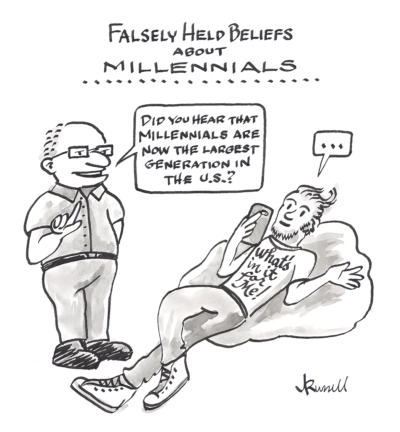Editor’s Note: This post is the first in an occasional series on our blog that looks at the impact of the Millennial generation (Gen Y) in the workplace from the perspective of our millennial-age consultants.
On April 25, the Pew Research Center released a report confirming that millennials now make up the largest generation in the United States. As expected, this news garnered a range of reactions.

Much is written on millennials – who we are, what we like, what we want and don’t want, and how to engage us – both in the popular press and from an HR and talent management perspective. In many cases, efforts to describe the generation are supported by solid data and good-faith intentions. Still, too much of the conversation falls back on generalizations that attempt to capture the key characteristics of the most diverse generation this country has ever seen.

“Successfully engaging a younger workforce involves a considered look at your own population – a commitment to determining who your millennials are, and what drives them.” – Rebecca Kuzemchak, Associate, Engagement.
Per PEW’s numbers, there are now 75.4 million millennials in the U.S. That’s 75.4 million people born between 1981 and 1997 (although PEW qualifies this age range by stating that “no chronological endpoint has been set for the group” as they will “continue to assess demographic, attitudinal and other evidence on habits and culture… to establish when the youngest millennial was born;” other estimates place the generation’s endpoints as early as 1980 and as late as 2004). The cohort’s size is expected to rise by around 5 million due to immigration, before peaking in 2036.
Taking 1981 and 1997 as bookends, the youngest millennial is now 18. The oldest is 35. The 35-year-old millennial is almost certainly in a different place – personally, professionally, and ideologically – than her 18-year old counterpart. She’s also almost certainly coming from a different place.
Millennials vary dramatically:
We show our age. Several commonly held concerns about millennials (that we’re self-centered or that we want immediate gratification, for example) can be attributed in large part to the life-cycle effect – to the relative effects of youth. People change their behavior as they age. Sometimes, the other generations forget this when they speak about us.
We grew up with different technologies. Millennials are made out to be digital natives – and in general, it’s fair to say that we’re probably more comfortable with technology as a part of our daily lives than our peers from older generations. Still, the technologies we grew up with (everything from telecommunications to data science to transit to medicine) vary dramatically depending on when and where we were born. The youngest millennial’s childhood concept of “computer” or “phone” is likely quite different from that of the oldest.
We represent various cultures. Millennials in the U.S. are more ethnically diverse than any previous generation, in large part due to increases in immigration from Latin America and Asia. According to the most recent U.S. Census data, 44.2 percent of the country’s millennial residents identify as non-white. Limited research has been published examining the impact of ethnic background on millennial workforce trends – our preferences, our goals and our requirements. Anecdotal feedback tells us that its effects are likely quite significant. (We’ll explore this in our next post.)
We have different socioeconomic backgrounds. The country’s increasing stratification impacted our upbringing in divergent ways, and continues to affect us differently as we find our place in the workforce. The recession hit us and our families in different ways. So has student loan debt.
These issues are not unique to millennials. Everyone, regardless of generation, occupies a distinct position that reflects their age, their technologies, and their specific socioeconomic and cultural backgrounds. However, you could argue – and I do – that these variations are more pronounced in Generation Y, and that they tie in directly to the different lifestyle preferences and social, political, and religious beliefs that characterize this cohort. They’re critical pieces of identity. And they don’t get talked about often enough when people consider “the millennial.”
When these variables come together to create the millennials who work for your company, you’re presented with a challenge: how to best attract, engage and retain them.
Generally, literature on millennials takes as fact that, because of the diversities mentioned above, engaging Gen Y workers requires alternative, targeted tactics. I would contest that.
First, the millennial generation is no different from those prior to it in that a certain amount of self-selection comes into play when a millennial goes through the job search process. Your millennials came to your company with at least a modicum of understanding of your culture and your processes. Although they may have some new ideas or unfamiliar preferences, these are likely no more dramatic than those that accompany any generational shift. If a millennial is truly opposed to or alienated by a company’s culture, and has a choice, he or she will probably choose not to work there.
Second, it’s imperative to recognize that data speaks – and it can be made to say what you’d like it to. While ample research has been done on generational preferences and on cross-generational engagement in the workplace, analysis and application of that data ultimately comes down to framing. If 60% of millennials who responded to a survey think X about issue XYZ, that leaves 40% of surveyed millennials who think otherwise, plus a host of un-surveyed millennials who may well have entirely disparate thought processes and preferences. Survey results can be framed to back the communication strategy of your choosing. Be careful.
As times change, employees’ needs, wants, and preferences change. This is not new, and it’s not unique to one generation. Millennial engagement is a popular topic – and for good reasons. But as we consider it, it’s critical to return to one of the most fundamental rules of employee engagement: one size does not fit all.
Millennials are diverse, in every sense of the word, and there are a lot of them in or entering the workforce. To have a real impact, benefit plan designs, HR programs, and engagement strategies that target millennials need to go beyond general-survey statistics. They certainly can’t hinge on generational stereotypes. Successfully engaging a younger workforce involves a considered look at your own population – a commitment to determining who your millennials are, and what drives them.